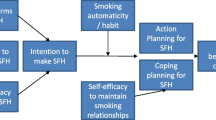Abstract
Community health advisors (CHAs), also known as promotores, are lay individuals in the community that others tend to look toward for advice and support. Studies incorporating CHAs are relatively rare, and CHAs have not been used in previous intervention studies to reduce environmental tobacco smoke (ETS) exposure. The present study pilot tested a CHA assessment instrument and examined the effects of promotora training on CHAs' knowledge, attitudes, and beliefs concerning ETS reduction. Participants were 11 women recruited from the local community. CHA training produced changes on several psychosocial constructs. Anticipated outcomes regarding ETS reduction and emotional reactions related to volunteering in the community were more positive after training. Self-esteem and self-efficacy showed increases after training. Future research will investigate the relationship between the psychosocial characteristics measured in the assessment instrument and subsequent success implementing the ETS reduction intervention.
Similar content being viewed by others
REFERENCES
U.S. Environmental Protection Agency (EPA): Respiratory Health Effects of Passive Smoking: Lung Cancer and Other Disorders. Washington, DC: U.S. Environmental Protection Agency, 1992
Wright AL, Holberg C, Martinez FD, Taussig LM: Relationship of parental smoking to wheezing and non-wheezing lower respiratory tract illnesses in infancy. J Pediatr 1991; 118:207-214
Martinez FD, Cline M, Burrows B: Increased incidence of asthma in children of smoking mothers. Pediatrics 1992; 89:21-260
Mannino DM, Siegel M, Husten C, Rose D, Etzel R: Environmental tobacco smoke exposure and health effects in children: Results from the 1991 National Health Interview Survey. Tob Control 1996; 5:13-18
Pirkle JL, Flegal KM, Bernert JT, Brody DJ, Etzel RA, Maurer KR: Exposure of the U.S. population to ETS: The third National Health and Nutrition Examination Survey, 1988–1991. JAMA 1996; 275:1233-1240
U.S. Department of Health and Human Services: Smoking and Health: A National Status Report. Centers for Disease Control and Prevention; 1990
County of San Diego: San Diego County vital statistics: In: Building Healthier Futures: A San Diego Plan for the Year 2000. San Diego, CA: County of San Diego; 1996
Hovell MF, Meltzer SB, Zakarian JM, et al.: Reduction of environmental tobacco smoke exposure among asthmatic children: A controlled trial. Chest 1994; 106:440-446
Greenberg RA, Strecher VJ, Bauman KE, et al.: Evaluation of a home-based intervention program to reduce infant passive smoking and lower respiratory illness. J Behav Med 1994; 17:273-290
Watkins EL, Harlan C, Eng E, Gansky SA, Gehan D, Larson K: Assessing the effectiveness of lay health advisors with migrant farmworkers. Fam Community Health 1994; 16:72-87
Estrada AL, Trevino FM, Ray LA: Health care utilization barriers among Mexican Americans: Evidence from HHANES 1982–1984. Am J Public Health 1990; 80:27-31
Israel B: Social networks and social support: Implications for natural helper and community level interventions. Health Educ Q 1985; 12:65-80
Werner D, Bower B: Helping Health Workers Learn: Palo Alto, CA: The Hesperian Foundation; 1995
Navarro AM, Senn KL, Kaplan RM, McNicholas L, Campo MC, Roppe B: Por La Vida intervention model for cancer prevention in Latinas. J Natl Cancer Inst 1995; 18:137-145
Meiser JS, Warrick LH, Zapién JG, Wood AH: Using lay health workers: Case study of a community-based prenatal intervention. J Community Health 1992; 17:37-51
Fishbein M, Bandura A, Triandis HC, Kanfer FH, Becker MH, Middlestadt SE, Eichler A: Factors Influencing Behavior and Behavior Change: Final Report—Theorist's Workshop. Rockville, MD: National Institute of Mental Health (NIMH); 1992
Rosenberg M: Conceiving the Self. New York: Basic Book; 1979
Valenzuela A: Familism and academic achievement among Mexican-origin high school adolescents. Doctoral Dissertation, Stanford University; 1990
Bandura A: Self-efficacy: Toward a unifying theory of behavioral change. Psychol Rev 1977; 84:191-215
Schwarzer R, Babler J, Kwiatek P, Schroder K: The assessment of optimistic self-beliefs: Comparison of the German, Spanish, and Chinese versions of the general self-efficacy scale. Appl Psychol: Int Rev 1997; 46(1):69-88
Feldman RH: The influence of communicator characteristics on the nutrition attitudes and behavior of high school students: J Sch Health 1984; 54:149-151
Author information
Authors and Affiliations
Corresponding author
Rights and permissions
About this article
Cite this article
Rodriguez, V.M., Conway, T.L., Woodruff, S.I. et al. Pilot Test of an Assessment Instrument for Latina Community Health Advisors Conducting an ETS Intervention. Journal of Immigrant Health 5, 129–137 (2003). https://doi.org/10.1023/A:1023991818829
Issue Date:
DOI: https://doi.org/10.1023/A:1023991818829




